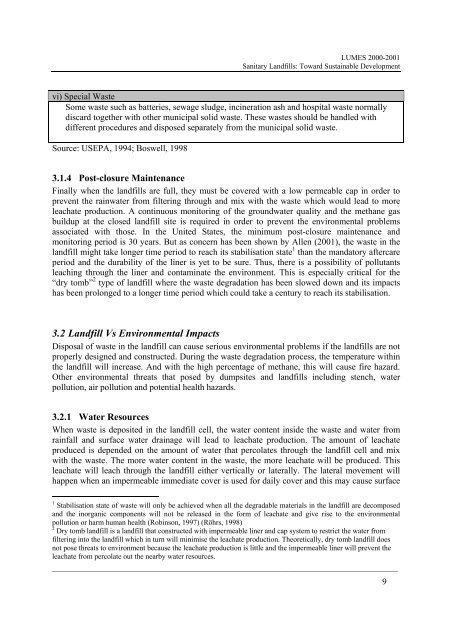Sanitary Landfills: Toward Sustainable Development - lumes
Sanitary Landfills: Toward Sustainable Development - lumes
Sanitary Landfills: Toward Sustainable Development - lumes
You also want an ePaper? Increase the reach of your titles
YUMPU automatically turns print PDFs into web optimized ePapers that Google loves.
LUMES 2000-2001<br />
<strong>Sanitary</strong> <strong>Landfills</strong>: <strong>Toward</strong> <strong>Sustainable</strong> <strong>Development</strong><br />
vi) Special Waste<br />
Some waste such as batteries, sewage sludge, incineration ash and hospital waste normally<br />
discard together with other municipal solid waste. These wastes should be handled with<br />
different procedures and disposed separately from the municipal solid waste.<br />
Source: USEPA, 1994; Boswell, 1998<br />
3.1.4 Post-closure Maintenance<br />
Finally when the landfills are full, they must be covered with a low permeable cap in order to<br />
prevent the rainwater from filtering through and mix with the waste which would lead to more<br />
leachate production. A continuous monitoring of the groundwater quality and the methane gas<br />
buildup at the closed landfill site is required in order to prevent the environmental problems<br />
associated with those. In the United States, the minimum post-closure maintenance and<br />
monitoring period is 30 years. But as concern has been shown by Allen (2001), the waste in the<br />
landfill might take longer time period to reach its stabilisation state 1 than the mandatory aftercare<br />
period and the durability of the liner is yet to be sure. Thus, there is a possibility of pollutants<br />
leaching through the liner and contaminate the environment. This is especially critical for the<br />
“dry tomb” 2 type of landfill where the waste degradation has been slowed down and its impacts<br />
has been prolonged to a longer time period which could take a century to reach its stabilisation.<br />
3.2 Landfill Vs Environmental Impacts<br />
Disposal of waste in the landfill can cause serious environmental problems if the landfills are not<br />
properly designed and constructed. During the waste degradation process, the temperature within<br />
the landfill will increase. And with the high percentage of methane, this will cause fire hazard.<br />
Other environmental threats that posed by dumpsites and landfills including stench, water<br />
pollution, air pollution and potential health hazards.<br />
3.2.1 Water Resources<br />
When waste is deposited in the landfill cell, the water content inside the waste and water from<br />
rainfall and surface water drainage will lead to leachate production. The amount of leachate<br />
produced is depended on the amount of water that percolates through the landfill cell and mix<br />
with the waste. The more water content in the waste, the more leachate will be produced. This<br />
leachate will leach through the landfill either vertically or laterally. The lateral movement will<br />
happen when an impermeable immediate cover is used for daily cover and this may cause surface<br />
1<br />
Stabilisation state of waste will only be achieved when all the degradable materials in the landfill are decomposed<br />
and the inorganic components will not be released in the form of leachate and give rise to the environmental<br />
pollution or harm human health (Robinson, 1997) (Röhrs, 1998)<br />
2<br />
Dry tomb landfill is a landfill that constructed with impermeable liner and cap system to restrict the water from<br />
filtering into the landfill which in turn will minimise the leachate production. Theoretically, dry tomb landfill does<br />
not pose threats to environment because the leachate production is little and the impermeable liner will prevent the<br />
leachate from percolate out the nearby water resources.<br />
______________________________________________________________________________<br />
9

















